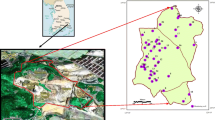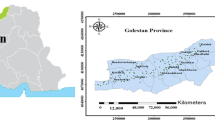Abstract
In recent years, groundwater level in Arak plain aquifer, Iran, declines due to overabstraction and sustainable management of the aquifer is changed to a vital issue. Spatiotemporal variation groundwater quality associated with identifying hydrogeochemical characteristics is the goal of this research. In the current study, graphical methods results are compared to two distinct clustering methods, hierarchical cluster analysis (HCA), and fuzzy C-mean (FCM) to analyze the hydrogeochemical dataset. Groundwater quality of Arak aquifer is monitored over an 11-year period in two-year intervals ranging from 2004 to 2014 (i.e., 2004, 2006, 2008, 2010, 2012, and 2014) by sampling from 52 abstraction wells for each year. Graphical methods identified dominant hydrogeochemical processes in the study area. The resulting clusters were categorized into freshwater (HC1, FC1), brackish-saline water (HC2, FC2), and saline water (HC3, FC3). The analysis resulted in three clusters including recharge, transition or mixing, and discharge zones, designated as FC1 and HC1, FC2 and HC2, and FC3 and HC3; respectively. The comparison of groundwater facies in 2004 and 2014 showed that the mixing zone (classes FC2 and FC3 and classes HC2 and HC3) has expanded with time. Observation well monitoring in the area showed that groundwater quality decrease due to groundwater level declines, especially in the residential zone. In addition, the role of geological formations in groundwater quality was evident in the distribution of clusters. Comprehensive regulation and integrated groundwater management is essential to prevent further degradation of groundwater quality in the region.














Similar content being viewed by others
Abbreviations
- AMSL:
-
Above mean sea level
- CBE:
-
Charge balance errors
- EC:
-
Electric conductivity
- FC1:
-
Cluster number 1 using fuzzy C-mean clustering
- FC2:
-
Cluster number 2 using fuzzy C-Mean Clustering
- FC3:
-
Cluster number 3 using fuzzy C-mean clustering
- FCM:
-
Fuzzy C-means clustering
- FPI:
-
Fuzziness performance index
- GIS:
-
Geographic information system
- HC1:
-
Cluster number 1 using hierarchical cluster analysis
- HC2:
-
Cluster number 2 using hierarchical cluster analysis
- HC3:
-
Cluster number 3 using hierarchical cluster analysis
- HCA:
-
Hierarchical cluster analysis
- NCE:
-
Normalized classification entropy
- M:
-
Fuzzification parameter
- TDS:
-
Total dissolved solids
References
Abu-alnaeem MF, Yusoff I, Ng TF, Alias Y, Raksmey M (2018) Assessment of groundwater salinity and quality in Gaza coastal aquifer Gaza Strip Palestine: an integrated statistical geostatistical and hydrogeochemical approaches study. Sci Total Environ 615:972–989. https://doi.org/10.1016/j.scitotenv.2017.09.320
APHA, A. American Public Health Association/American Water Works Association/Water Environment Federation (1998) Standard methods for the examination of water and wastewater. WPCF, Washington DC
Azizi F, Vadiati M, Moghaddam AA, Nazemi A, Adamowski J (2019) A hydrogeological-based multi-criteria method for assessing the vulnerability of coastal aquifers to saltwater intrusion. Environ Earth Sci 78(17):548
Bezdek JC (1981) Pattern recognition with fuzzy objective function algorithms. Plenum Press, New York. https://doi.org/10.1007/978-1-4757-0450-1
Cassalho F, Beskow S, de Mello CR, de Moura MM, de Oliveira LF, de Aguiar MS (2019) Artificial intelligence for identifying hydrologically homogeneous regions: a state-of-the-art regional flood frequency analysis. Hydrol Process 33(7):1101–1116. https://doi.org/10.1002/hyp.13388
Chebotarev II (1955) Metamorphism of natural waters in the crust of weathering—1. Geochim Cosmochim Acta 8(1–2):22–48
Cloutier V (2004) Origin and geochemical evolution of groundwater in the Paleozoic Basses-Laurentides sedimentary rock aquifer system St Lawrence Lowlands Québec Canada. Doctoral dissertation, Ph.D. Thesis, INRS—Eau Terre and Environment Quebec Canada (in French and English)
Cloutier V, Lefebvre R, Therrien R, Savard MM (2008) Multivariate statistical analysis of geochemical data as indicative of the hydrogeochemical evolution of groundwater in a sedimentary rock aquifer system. J Hydrol 353(3–4):294–313. https://doi.org/10.1016/j.jhydrol.2008.02.015
Dunn JC (1974) A fuzzy relative ISODATA process and its use in detecting compact well-separated clusters. J Cybern 3:32–57. https://doi.org/10.1080/01969727308546046
Durov SA (1948) Natural waters and graphic representation of their composition. Dokl Akad Nauk SSSR 59(3):87–90 [Environmental Protection Agency (EPA) 2001—parameters of water quality: interpretation and standards Ireland 133 p]
Esmaeili-Falak M, Katebi H, Vadiati M, Adamowski J (2019) Predicting triaxial compressive strength and Young’s modulus of frozen sand using artificial intelligence methods. J Cold Regions Eng 33(3):04019007
Fetter CW (1994) Applied hydrogeology. Prentice Hall, New York
Freeze RA, Cherry JA (1979) Groundwater. Prentice-Hall Inc., Englewood Cliffs
Gibbs RJ (1970) Mechanisms controlling world water chemistry. Science 170(3962):1088–1090. https://doi.org/10.1126/science.170.3962.1088
Gorgij AD, Kisi O, Moghaddam AA, Taghipour AA (2017) Groundwater quality ranking for drinking purposes, using the entropy method and the spatial autocorrelation index. Environ Earth Sci 76(3):269. https://doi.org/10.1007/s12665-017-6589-6
Güler C, Thyne GD (2004) Delineation of hydrochemical facies distribution in a regional groundwater system by means of fuzzy c-means clustering. Water Resour Res 40(12):1–11. https://doi.org/10.1029/2004WR003299
Güler C, Thyne GD, McCray JE, Turner KA (2002) Evaluation of graphical and multivariate statistical methods for classification of water chemistry data. Hydrogeol J 10(4):455–474. https://doi.org/10.1007/s10040-002-0196-6
Güler C, Kurt MA, Alpaslan M, Akbulut C (2012) Assessment of the impact of anthropogenic activities on the groundwater hydrology and chemistry in Tarsus coastal plain (Mersin SE Turkey) using fuzzy clustering multivariate statistics and GIS techniques. J Hydrol 414(3):435–451. https://doi.org/10.1016/j.jhydrol.2011.11.021
Hem JD (1985) Study and interpretation of the chemical characteristics of natural water (Vol 2254) Department of the Interior US Geological Survey USGS. Water Supply Pap 2254(1):117–120
Hill RA (1940) Geochemical patterns in Coachella valley. EOS Trans Am Geophys Union 21(1):46–53
Hoppner F (2002) Speeding up fuzzy c-means: using a hierarchical data organisation to control the precision of membership calculation. Fuzzy Sets Syst 128(3):365–376. https://doi.org/10.1016/S0165-0114(01)00204-4
Hounslow A (2018) Water quality data: analysis and interpretation. CRC Press, Boca Raton
IBM Corp (2016) IBM SPSS Statistics for Windows, Version 24.0. IBM Corp, Armonk, NY
Jankowski J, Acworth RI, Shekarforoush S (1998) Reverse ion-exchange in deeply weathered porphyritic dacite fractured aquifer system Yass New South Wales Australia. In: Arehart GB, Hulston JR (eds) Proceedings of the 9th international symposium on water–rock interaction, Taupo, New Zealand, 30 March–April 1998, Balkema, Rotterdam, pp 243–246
Khurshid S (2004) Aquifer geometry and hydrochemical framework of the shallow alluvial aquifers in the western part of the Yamuna River Basin India. Water Qual Res J 39(2):129–139. https://doi.org/10.2166/wqrj.2004.020
Li C, Gao X (2018) Assessment of groundwater quality at Yuncheng Basin: denotation for the water management in China. Groundwater. https://doi.org/10.1111/gwat.12834
Masoud AA, El-Horiny MM, Atwia MG, Gemail KS, Koike K (2018) Assessment of groundwater and soil quality degradation using multivariate and geostatistical analyses Dakhla Oasis Egypt. J Afr Earth Sc 142(1):64–81. https://doi.org/10.1016/j.jafrearsci.2018.03.009
Minasny B, McBratney AB (2002) FuzME version 3. Australian Center for Precision and Agriculture, University of Sydney, Sydney, NSW, Australia. https://www.usyd.edu.au/su/agric/acpa
Nadiri AA, Moghaddam AA, Tsai FT, Fijani E (2013) Hydrogeochemical analysis for Tasuj plain aquifer Iran. J Earth Syst Sci 122(4):1091–1105. https://doi.org/10.1007/s12040-013-0329-4
Peng K, Li X, Wang Z (2015) Hydrochemical characteristics of groundwater movement and evolution in the **nli deposit of the Sanshandao gold mine using FCM and PCA methods. Environ Earth Sci 73(12):7873–7888. https://doi.org/10.1007/s12665-014-3938-6
Piper AM (1944) A graphic procedure in the geochemical interpretation of water-analyses. Eos Trans Am Geophys Union 25(6):914–928
Piper AM, Garrett AA (1953) Native and contaminated ground waters in the long Beach-Santa Ana Area California US, Geological Survey of Water-Supply Paper 1136
Radfar J, Kohansal R (2004) 1:100000 Geology map of ArakNational Geoscience Database of Iran
Rakotondrabe F, Ngoupayou JRN, Mfonka Z, Rasolomanana EH, Abolo AJN, Ako AA (2018) Water quality assessment in the Bétaré-Oya gold mining area (East-Cameroon): multivariate statistical analysis approach. Sci Total Environ 610:831–844. https://doi.org/10.1016/j.scitotenv.2017.08.080
Rao AR, Srinivas VV (2008) Regionalization of watersheds: an approach based on cluster analysis, vol 58. Springer Science and Business Media, New York. https://doi.org/10.1007/978-1-4020-6852-2
RockWare Inc (1999) RockWorks plotting software. Golden
Roubens M (1982) Fuzzy clustering algorithms and their cluster validity. Eur J Oper Res 10(3):294–301. https://doi.org/10.1016/0377-2217(82)90228-4
Salem EZ, Osman MO (2017) Use of major ions to evaluate the hydrogeochemistry of groundwater influenced by reclamation and seawater intrusion West Nile Delta Egypt. Environ Sci Pollut Res 24:3675–3704. https://doi.org/10.1007/s11356-016-8056-4
Todd DK, Mays LW (2005) Groundwater hydrology. Wiley Inter, Hoboken, p 656
Vadiati M, Nakhaei M, Amiri V, Mirarabi A (2013) An assessment of the karoon river’s water quality using the fuzzy inference model. Water Eng 18(6):39–48
Vadiati M, Nalley D, Adamowski J, Nakhaei M, Asghari-Moghaddam A (2019) A comparative study of fuzzy logic-based models for groundwater quality evaluation based on irrigation indices. J Water Land Dev 43:158–170
Van den Brink C, Frapporti G, Griffioen J, Zaadnoordijk WJ (2007) Statistical analysis of anthropogenic versus geochemical-controlled differences in groundwater composition in the Netherlands. J Hydrol 336(3–4):470–480. https://doi.org/10.1016/j.jhydrol.2007.01.024
Ward JH (1963) Hierarchical grou** to optimize an objective function. J Am Stat Assoc 301:236–244
Wilks DS (2011) Statistical methods in the atmospheric sciences. In: Dmowska R, Hartmann D, RossbyHT (eds) Statistical Methods in the Atmospheric Sciences. Academic Press, USA
Wu C, Wu X, Qian C, Zhu G (2018) Hydrogeochemistry and groundwater quality assessment of high fluoride levels in the Yanchi endorheic region northwest, China. Appl Geochem 98:404–417. https://doi.org/10.1016/j.apgeochem.2018.10.016
**e XL, Beni G (1991) A validity measure for fuzzy clustering. IEEE Trans Pattern Anal 13:841–847. https://doi.org/10.1109/34.85677
Xu B, Wang G, Yang Q, Zheng Y (2018) Hydrological buffering during groundwater acidification in rapidly industrializing alluvial plains. J Contam Hydrol 218:19–33. https://doi.org/10.1016/j.jconhyd.2018.08.006
Acknowledgements
The authors wish to extend thanks to the Markazi Regional Water Authority for providing a significant portion of the data used to complete this study.
Author information
Authors and Affiliations
Corresponding author
Additional information
Publisher's Note
Springer Nature remains neutral with regard to jurisdictional claims in published maps and institutional affiliations.
Rights and permissions
About this article
Cite this article
Rahbar, A., Vadiati, M., Talkhabi, M. et al. A hydrogeochemical analysis of groundwater using hierarchical clustering analysis and fuzzy C-mean clustering methods in Arak plain, Iran. Environ Earth Sci 79, 342 (2020). https://doi.org/10.1007/s12665-020-09064-6
Received:
Accepted:
Published:
DOI: https://doi.org/10.1007/s12665-020-09064-6




